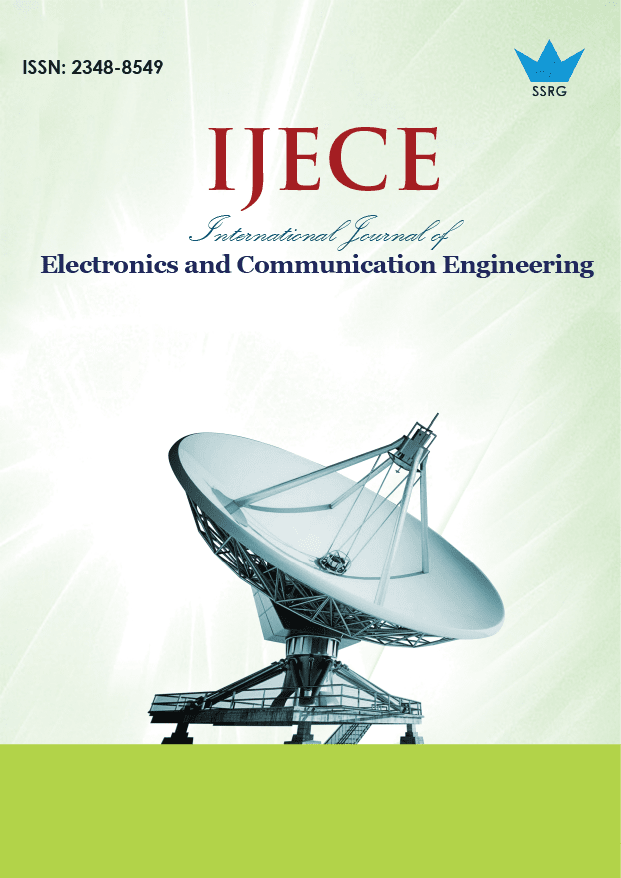Internet Accessibility Optimization in Mobile Ad-hoc Networks (MANETs)

| International Journal of Electronics and Communication Engineering |
| © 2025 by SSRG - IJECE Journal |
| Volume 12 Issue 3 |
| Year of Publication : 2025 |
| Authors : Atma Prakash Singh, Hitendra Singh, Rakesh Kumar Yadav |
How to Cite?
Atma Prakash Singh, Hitendra Singh, Rakesh Kumar Yadav, "Internet Accessibility Optimization in Mobile Ad-hoc Networks (MANETs)," SSRG International Journal of Electronics and Communication Engineering, vol. 12, no. 3, pp. 110-115, 2025. Crossref, https://doi.org/10.14445/23488549/IJECE-V12I3P110
Abstract:
Internet accessibility is particularly challenged by Mobile Ad hoc Networks (MANETs) because of their dynamic, self-organizing topology and lack of fixed infrastructure. This work investigates the optimization of internet connectivity in MANETs to solve the inherent difficulties of resource restrictions, bandwidth limitations, and frequent topology changes. In order to address the difficulties of maintaining consistent internet connectivity in such environments, the article looks at existing load-balancing techniques, spectrum management techniques, and routing algorithms. The study also examines how caching techniques and QoS enhancements could improve connection and performance. By analyzing current approaches and proposing novel ones, this study aims to increase the effectiveness of internet accessibility in MANETs. The findings offer guidance on maximising connectivity and performance, which is crucial for applications in disaster recovery, military operations, and other scenarios where conventional infrastructure is impractical. By increasing the reliability and efficiency of MANET technologies, this work contributes to these networks' increased functionality and usefulness in a range of demanding situations.
Keywords:
Mobile Ad-Hoc Networks (MANETs), Astute caching, Balancing loads, Network efficiency and Optimization of bandwidth, Protocols for routing, Quality of Service (QoS), Spectrum handling.
References:
[1] Sheng Zhong, and Yuan Zhang, “How to Select Optimal Gateway in Multi-Domain Wireless Networks: Alternative Solutions without Learning,” IEEE Transactions on Wireless Communications, vol. 12, no. 11, pp. 5620-5630, 2013.
[CrossRef] [Google Scholar] [Publisher Link]
[2] Rafi U. Zaman, Khaleelur Khan, and A. Venugopal Reddy, “Gateway Load Balancing in Integrated Internet-MANET Using WLB-AODV,” Proceedings of the International Conference and Workshop on Emerging Trends in Technology, Mumbai Maharashtra India, pp. 411-416, 2010.
[CrossRef] [Google Scholar] [Publisher Link]
[3] Nabhendra Bisnik, and Alhussein A. Abouzeid, “Queuing Network Models for Delay Analysis of Multihop Wireless Ad Hoc Networks,” Ad Hoc Networks, vol. 7, no. 1, pp. 79-97, 2009.
[CrossRef] [Google Scholar] [Publisher Link]
[4] Tie Qiu et al., “Queueing Theory-Based Path Delay Analysis of Wireless Sensor Networks,” Advances in Electrical and Computer Engineering, vol. 11, no. 2, pp. 3-8, 2011.
[CrossRef] [Google Scholar] [Publisher Link]
[5] Jay Prakash, Rakesh Kumar, and Jai Prakash Saini, “Path Load Balancing Adaptive Gateway Discovery in MANET-Internet Integration Using PSO,” International Journal of Intelligent Engineering & System, vol. 10, no. 4, pp. 235-244, 2017.
[CrossRef] [Google Scholar] [Publisher Link]
[6] Pratyay Kuila, Suneet K. Gupta, and Prasanta K. Jana, “A Novel Evolutionary Approach for Load Balanced Clustering Problem for Wireless Sensor Networks,” Swarm and Evolutionary Computation, vol. 12, pp. 48-56, 2013.
[CrossRef] [Google Scholar] [Publisher Link]
[7] Usama Mehboob et al., “Genetic Algorithms in Wireless Networking: Techniques, Applications, and Issues,” Soft Computing, vol. 20, pp. 2467-2501, 2016.
[CrossRef] [Google Scholar] [Publisher Link]
[8] Yun-Sheng Yen et al., “Flooding-Limited and Multi-Constrained QoS Multicast Routing Based on the Genetic Algorithm for MANETs,” Mathematical and Computer Modelling, vol. 53, no. 11-12, pp. 2238-2250, 2011.
[CrossRef] [Google Scholar] [Publisher Link]
[9] Hui Cheng, Shengxiang Yang, and Jiannong Cao, “Dynamic Genetic Algorithms for the Dynamic Load Balanced Clustering Problem in Mobile ad Hoc Networks,” Expert Systems with Applications, vol. 40, no. 4, pp. 1381-1392, 2013.
[CrossRef] [Google Scholar] [Publisher Link]
[10] Yong Qiang Li et al., “Reliable Ant Colony Routing Algorithm for Dual-Channel Mobile Ad Hoc Networks,” Wireless Communications and Mobile Computing, vol. 2018, no. 1, pp. 1-10, 2018.
[CrossRef] [Google Scholar] [Publisher Link]
[11] Laura Rosati, Matteo Berioli, and Gianluca Reali, “On Ant Routing Algorithms in Ad Hoc Networks with Critical Connectivity,” Ad Hoc Networks, vol. 6, no. 6, pp. 827-859, 2008.
[CrossRef] [Google Scholar] [Publisher Link]
[12] Gurpreet Singh, Neeraj Kumar, and Anil Kumar Verma, “OANTALG: An Orientation Based Ant Colony Algorithm for Mobile Ad Hoc Networks,” Wireless Personal Communications, vol. 77, pp. 1859-1884, 2014.
[CrossRef] [Google Scholar] [Publisher Link]
[13] Fernando Correia, and Teresa Vazao, “Simple Ant Routing Algorithm Strategies for a (Multipurpose) MANET Model,” Ad Hoc Networks, vol. 8, no. 8, pp. 810-823, 2010.
[CrossRef] [Google Scholar] [Publisher Link]
[14] Jianping Wang et al., “HOPNET: A Hybrid Ant Colony Optimization Routing Algorithm for Mobile Ad Hoc Network,” Ad Hoc Networks, vol. 7, no. 4, pp. 690-705, 2009.
[CrossRef] [Google Scholar] [Publisher Link]
[15] Radwa Attia, Rawya Rizk, and Mahmoud Mariee, “A Hybrid Multi-Path ant QoS Routing Algorithm for MANETs,” IFIP International Conference on Wireless and Optical Communications Networks, Cairo, Egypt, pp. 1-5, 2009.
[CrossRef] [Google Scholar] [Publisher Link]

 10.14445/23488549/IJECE-V12I3P110
10.14445/23488549/IJECE-V12I3P110